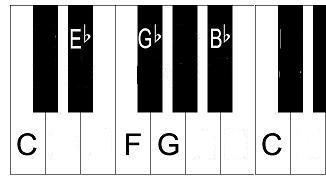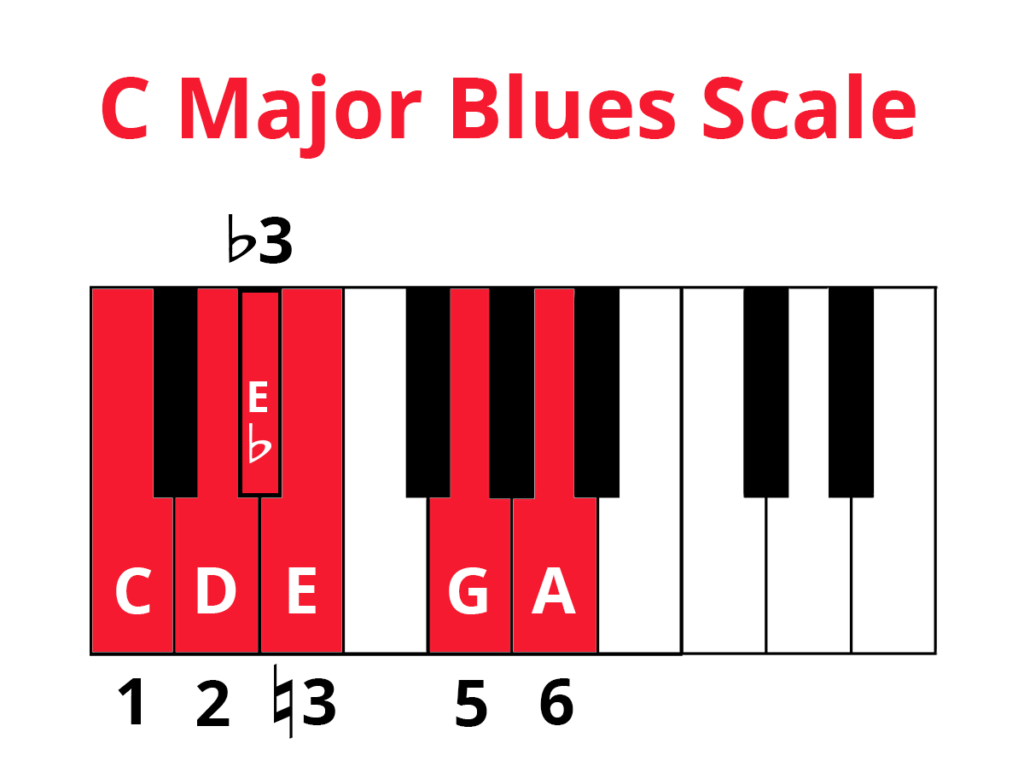Piano blues scales are a series of notes that create a bluesy sound. These scales form the foundation for blues improvisation and melody creation.
Now, if you’re interested in the rich tones of blues music, understanding piano blues scales is essential. These scales add soulful color and emotional depth to the music, opening a gateway to heartfelt expression. Whether you’re a beginner pianist or an experienced musician, mastering these scales can transform your playing.
They consist typically of a minor pentatonic scale with an added flat fifth, or “blue note,” which gives the scale its distinctive sound. This sound has become synonymous with the lamenting vibe of blues music, and it’s an indispensable tool for any aspiring blues pianist. By honing your skills in these scales, you unlock the ability to convey the classic blues feel that has captivated audiences for generations.

Credit: www.piano-keyboard-guide.com
Origins Of Piano Blues Scales
The ‘Origins of Piano Blues Scales’ trace a rich history, steeped in emotion and culture. These scales form the backbone of blues music and are essential for creating its distinctive sound. Let’s dive deep into its roots and evolution.
Roots In African Music
Blues scales have a deep connection with African music. They originate from the traditional African scales used in spirituals, work songs, and chants. Africans brought their musical heritage to America during the slave trade. Here it blended with new musical forms.
- Focus on rhythmic complexity and vocal inflections
- Use of pentatonic scales with flattened notes
- Influence from African instruments like the balafon and kora
Evolution In American History
The piano blues scale evolved as African music adapted to American life. Slavery and the African diaspora played a huge role in this transformation. Blues scales became a form of expression for the African American community’s struggles and emotions.
Their incorporation into piano music marked a fusion of cultures. It helped develop a unique American sound.
Key moments include:
- The rise of ragtime and jazz
- Development of Southern blues styles
- The Great Migration’s influence on urban blues
Noted pianists like W.C. Handy and Jelly Roll Morton were pivotal in popularizing blues scales. They helped craft the soundtrack of American history.
Essential Notes In Blues Scales
The piano blues scale is a musical ladder filled with soul and expression. This scale’s notes are the stairs leading to the heart of blues music. Think of them as a secret code to unlocking classic blues sounds. These notes weave the fabric of a rich musical heritage. Let’s dive into the essential notes that make the blues scale so distinctive.
Breaking Down The Scale
Understanding the blues scale’s structure is like uncovering a treasure map. It consists of six notes that form the path to bluesy improvisation. Here’s the standard blueprint of the blues scale in C:
- C – The root note, the scale’s starting point.
- Eb – A flat third, adding a hint of melancholy.
- F – The fourth note, stable and familiar.
- F# – The sharp fourth or blue note, the scale’s spicy kick.
- G – The fifth note, solid and reliable.
- Bb – A flat seventh, giving a yearnful pull.
These notes can turn simple melodies into bluesy phrases that resonate with emotion.
The Role Of The Blue Note
The blue note, also known as the “worried” note, brings a unique flavor to the blues scale. Its technical name is the tritone, and it sits between the fourth and fifth notes. In the key of C, this is the F#.
| Note | Name | Role |
|---|---|---|
| F# | Blue Note | The heart of the blues sound |
It’s this note that gives the blues its distinctive tension and release. Players linger on, bend, and play around this note. It creates a feeling that something is unresolved, which is essential in blues music.
With the blue note, artists tell a story of sorrow, joy, and everything in between. These scales are not just about the notes played. It’s about the feelings they echo through the keys.
Playing Blues Scales On Piano
Picture this: your hands dancing across the keys, creating soulful melodies. That’s the power of piano blues scales. They’re essential for blues piano music. The blues scale gives tunes a unique, smooth sound. Let’s explore how to play these scales with ease.
Fingering Techniques
Fingering techniques are crucial for playing blues scales fluently. Correct fingers make playing faster and easier. Here are some tips:
- Start slow: Learn which finger goes on each key.
- Consistent practice: Muscle memory will kick in with time.
- Thumb under technique: Use your thumb to glide to the next octave.
For example, the C blues scale fingering is as follows:
| Note | Finger (RH) | Finger (LH) |
|---|---|---|
| C | 1 | 5 |
| Eb | 2 | 4 |
| F | 3 | 3 |
Practice Exercises
Mastery comes from practice. Try these exercises to improve:
- Play the scale up and down.
- Increase speed gradually.
- Practice with a metronome.
- Try in different keys.
Remember, play each note clearly. Accuracy is better than speed at the start. With these exercises, blues scales will become second nature. Keep practicing, and soon you’ll be playing blues scales like a pro.

Credit: www.pianote.com
Impacting Musical Genres
The piano blues scale is a powerful tool for musicians. It bridges various musical genres, creating a rich tapestry of sound that shapes much of the music we love today. The five or six-note scale carries a signature sound recognizable in blues, jazz, and even rock and pop music. Let’s explore how the piano blues scale has left its indelible mark on different genres.
Influence On Jazz
Jazz music thrives on improvisation and expression, and the blues scale is pivotal in this. Jazz pianists often harness the soulful nuances of the blues scale to craft solos that resonate with emotion. Artists like Thelonious Monk and Bill Evans used the blues scale to color their music, blending tradition with innovation. Here are some ways the blues scale impacts jazz:
- It forms the foundation for many jazz standards.
- It’s a key element for creating the swing feel characteristic of jazz.
- It provides a means for melodic storytelling within jazz improvisation.
Blues Scales In Rock And Pop
In rock and pop, the blues scale brings an edge and vitality to melodies and solos. It’s a testament to the scale’s versatility. Musicians like Elton John and Billy Joel have sprinkled blues scales throughout their hit songs, giving them depth and a touch of rawness. The blues scale is a secret ingredient for many rock guitarists and pianists, driving the genre’s iconic sound.
| Element | Impact |
|---|---|
| Powerful Solos | Blues scales contribute to the expressive solos in rock songs. |
| Riffs and Hooks | Many memorable riffs are based on blues scale patterns. |
| Emotional Content | Songs gain depth and emotional resonance from the scale. |
Famous Blues Pianists And Their Styles
Every blues pianist has a unique style. Their music tells stories. Blues scales are their words. In the world of piano blues, some stars shine the brightest. Let’s dive into the world of famous blues pianists and their distinctive sounds.
Legends Of Blues Piano
These artists set the stage for blues piano. They made history with their talent.
- Pine Top Smith – Known for popularizing the “boogie woogie” style.
- Ray Charles – Blended blues with other genres, creating soulful melodies.
- Dr. John – Infused New Orleans jazz, blues, and funk into his piano playing.
Each legend had a method to their keys. Their styles evolved with time and are classic examples of blues expression.
Contemporary Blues Pianists
Today’s blues pianists keep the flame alive. They take cues from the past and add modern twists.
| Pianist | Style |
|---|---|
| Marcia Ball | Powerful singing with Texas-Louisiana inspired blues. |
| Joe Bonamassa | Fuses rock guitar with old-school piano blues. |
| Eden Brent | Combines jazz, blues, and a slice of pop. |
These artists show that the blues scale is timeless. It grows but never loses its roots.

Credit: www.youtube.com
Are Minor Scales Related to Piano Blues Scales?
Yes, piano minor scale explained is related to piano blues scales. The minor scale is often used in blues music to create a melancholic and soulful sound. It adds a rich and emotional depth to the music, making it a popular choice for blues piano players.
Frequently Asked Questions On What Is Piano Blues Scales
What Defines A Blues Scale?
A blues scale consists of six notes: the root, flat third, fourth, flat fifth, fifth, and flat seventh of the major scale. It creates a recognizable, soulful sound integral to blues music.
What Is The Difference Between The Major Scale And The Blues Scale?
The major scale consists of seven notes with whole and half-step intervals. The blues scale adds flattened third, fifth, and seventh notes, creating a distinct five-note pentatonic sequence with bluesy character.
What Is The Difference Between The Minor Scale And The Blues Scale?
The minor scale follows a specific pattern of whole and half steps, while the blues scale adds flattened third and seventh notes, as well as a blues note, for a characteristic sound.
What Is Blues Scale In A Notes?
The blues scale is a six-note sequence that adds a flattened fifth to the pentatonic scale. It typically consists of the root, minor third, fourth, diminished fifth, perfect fifth, and minor seventh.
Conclusion
Mastering piano blues scales can elevate your playing and improvisation skills. It’s a musical journey worth taking for any pianist. Embrace these scales, practice consistently, and the soulful essence of blues will soon flow through your melodies. Begin your blues adventure today and unlock the door to expressive playing.
